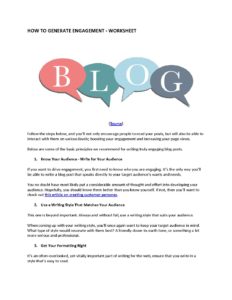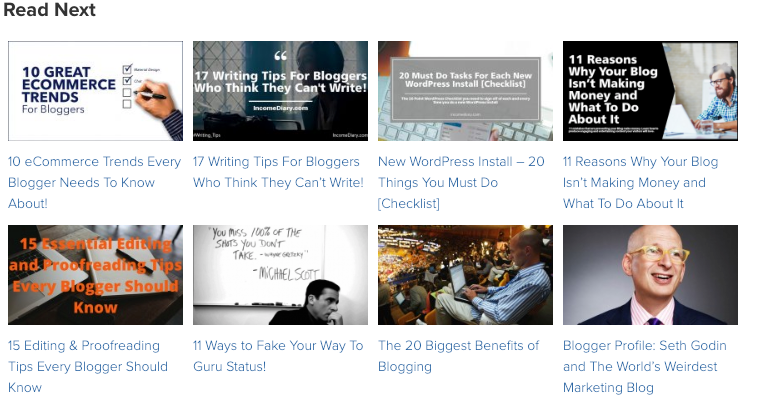If you own a blog and nobody reads it, does it really exist?
In many ways, no!
For your blog to be significant and meaningful, it needs to get noticed, and it needs to drive engagement. This means creating the buzz factor. Not only do you need people clicking on your posts, but you also need them reading them –and ideally, commenting on them, sharing, liking, and retweeting them too.
This type of engagement isn’t something you can buy, nor can you force it.
What does the secret sauce consist of?
It’s a special blend of tips, tricks, and basic principles that can help you to write truly engaging blog posts –and then share them successfully.
Follow the steps below, and you’ll not only encourage people to read your posts, but will also be able to interact with them on various levels; boosting your engagement and increasing your page views.
Below are some of the basic principles we recommend for writing truly engaging blog posts.
Know Your Audience – Write for Your Audience
If you want to drive engagement, you first need to know who you are engaging. It’s the only way you’ll be able to write a blog post that speaks directly to your target audience’s wants and needs. You no doubt have most likely put a considerable amount of thought and effort into developing your audience.
Hopefully, you should know them better than you know yourself. If not, then you’ll want to check out this article on creating customer personas. Realize that these people are the foundation of your blog. You should always be thinking about how you can help them and what they are demanding.
So it should already be a foregone conclusion that you understand exactly who they are, what topics they need help with and exactly how you and your blog can help them. It is essential that you are able to answer this one key question: My blog helps [_____] who [___________].Taking a general high traffic B2C blog as an example:
“My blog helps e-commerce businesses who want to get more customers.”
Once this question is answered, you can move on to creating buyer personas for your target audience. Also be aware that your reader’s needs will shift over time.
A buyer persona is a profile of your ideal reader (or customer) where you’ll answer other questions covering demographic information, goals, challenges and more.
Developing buyer personas should be a continual exercise you go through as your blog develops. Neil Patel has a great article on creating a buyer persona as well.
Use a Writing Style That Matches Your Audience
This one is beyond important. Always and without fail, use a writing style that suits your audience. When coming up with your writing style, you’ll once again want to keep your target audience in mind. What type of style would resonate with them best? A friendly down-to-earth tone, or something a bit more serious and professional.
A majority of blogs choose to use the former; a friendly, down-to-earth style. It’s ideal for information-centered blogs (like blogs about food, kittens, digital marketing, etc.), personal blogs, and basically everything in between. The key marker in this style is the conversational tone.
It should be relaxed, casual and approachable. Adopting a formal tone, on the other hand, should be reserved primarily for B2B blogs. Just be sure that you pick a tone and you stick with it. There are of course differing tones within each category as well.
Get Your Formatting Right
It’s an often-overlooked, yet vitally important part of writing for the web, ensure that you write in a style that’s easy to read.
This means keeping in mind that your online readers have a notoriously short attention span, and few things will drive them away faster than a looming wall of text. Psychologically, if an article looks “hard” to read, people won’t read it. So break it up into easily digestible chunks. Instead of writing long-winded paragraphs, it’s important to make sure your thoughts are easy to read –and skimmable.
Here’s a look at a few tips for writing for the web:
- Use bullet points to convey your message whenever possible, avoiding run-on sentences
- Break up your paragraphs –keep them just a few sentences long
- Use bold, italics, and different font sizes or styles to call attention to different sections
- Use subheadings to make your content skimmable
Start Strong
Your opening paragraph is your de facto first impression. And we all know how important first impressions are! You need to capture your reader’s attention. Avoid using the formulaic thesis statement and add some pizzazz. For example, start with a question, with a statement of value, with a fascinating statistic; something to engage the reader and captivate their attention.
Keep It Clean Folks
Clutter is an engagement killer. If your website is crammed full of endless sidebar widgets, maintains 51 different plugins, and has ads galore, your bounce rate is probably through the roof. Let’s take Shibuya, Tokyo or Times Square, New York for an example. Your website should not look like this: Take, for example, Times Square and Shibuya Square pictured above. Yes, we’d like to visit here. No, your website should not look like this.Stick to one (maybe two) fonts. Beyond that, there should be no font changes, no font color changes, and no font size changes. Your website needs to look consistent.
Take, for example, Times Square and Shibuya Square pictured above. Yes, we’d like to visit here. No, your website should not look like this.Stick to one (maybe two) fonts. Beyond that, there should be no font changes, no font color changes, and no font size changes. Your website needs to look consistent.
Go easy on the widgets too. We recommend having a subscription form at the top, a short “about me” piece, some recent posts, your social share buttons, and four 125×125 affiliate banner ads at the very most.
Without a doubt, always avoid images in the sidebar. They only serve to distract the reader from engaging with your content. Your copy should not be competing with flashy ads. You’re better than that.
Also, try to make sure the images fit with the rest of theme. Even if you’re using GIFs, get them as high-quality as you can, and avoid pixilating them.
As a good general rule, the less you have going on, the easier it’ll be for your visitors to focus on your content.
Have a Subscription Form at the End of Every Post
This is a fantastic method to get the most out of your traffic. It will keep ‘em coming back and also grow your email list for remarketing! All you need to do is put together a catchy call to action (CTA) that resonates with your audience. Give them a reason to get the emails. Offer exclusive content in a newsletter or discount codes.
Your CTA can be as simple as; “Join 10,000 others who have opted to receive this newsletter! Or go for something more witty if it fits the feel of your site. Just make sure the CTA matches the general feel and message of the content.
Include Something New
Perhaps you want to write about a popular topic that has been written about many times over. Like “creating the perfect Instagram post.” Before you write a word, start by doing a little research. Get on Facebook, or SEM Rush and see what you can find. Look at how other posts have covered the topic and most importantly, what they may have left out.Maybe they failed to include a screenshot with handy mark-ups.
Did they provide reviews on free graphic design services like Canva that anyone can use?Rest assured, new things come out all time. You’ll be able to find something that didn’t get covered. Once you’ve unearthed out some tasty tidbits, drop them into your post.
This move will help to increase your chance of getting comments, social shares, and links because people will actually get some utility from your content. Remember: people love useful content. Your job is to do the research, so your reader doesn’t have to.
Get Visual
Writing about a topic that has visual appeal or can be improved by some eye candy? Use them. Screenshots, photographs, or graphs are all great ways to break up your copy and help the reader stay engaged.
It’s one thing to write a post about LinkedIn Advertising, but it’s another beast all-together if you can provide a tutorial with step by step instructions and screenshots. It’s these details that go the extra mile and will enable your posts to stand out for the clutter.
Get our How to Generate Engagement Worksheet delivered right to your inbox.
Display Related Content
It’s also important that you display related posts at the end of each and every post. You have your audience already on your site. So why not try to keep them there a bit longer?There is also a bit of psychology to go along with this. Once a reader is finished with content, they immediately are trying to figure out what to do next.
“Where do I go?” They ask themselves.“ Should I sign up through your opt-in form?” or, “Should I hit the back button and leave the website?” or, “Should they go ahead and browse some more posts?” Help guide them with their decision and make it easier.
This is often a subconscious action, and therefore a design solution is applicable here. By adding related content at the bottom of posts, you help them make the correct decision (read more of your content!) Although it is possible to set this up manually on your site, we recommend utilizing a plugin purpose built for this. It’s much more efficient and appealing.
An example of related content on IncomeDiary.com.
An excellent way to boost engagement. [Image source]
Social Media Sharing
Yes, this one is rather obvious, but we still wanted to mention is, due to its importance. SEO and SMM (social media marketing) are two birds of a feather. When Google is indexing your site, they are looking for social cues to indicate your content is popular and relevant.
If they see your content over multiple platforms, your rankings will increase!When designing your site, whether it is on Squarespace, WordPress, or Wix, be sure you have social share buttons on all of your posts. The channels you select will be determined by your audience, however Facebook and Twitter and the go-to standards.
Also be sure to follow up with all social comments and share. We like to say you should be doing five comments for every one item you post. This goes a long way in improving your brand’s perceptions and developing close ties with your forums and online communities.
Use Trigger Words That Engage
The words that you use are as important as how you use them. Using the correct language will compel people to take the prescribed action you want them to. This will also increase audience engagement, content engagement, and social media engagement.
The proper wordsmithing can transform your blog posts from “What a mess” to “This is amazing!”The right mix of words is a paramount part of your overarching content strategy. Using them will also help you to become a better writer by learning how to pepper in the right trigger words in your content.Here are five of excellent trigger words that you should try using in your next blog post, to help increase audience engagement:
- Free
Everyone loves free stuff! Period.Also realize that the word “Free” is much more effective than, “almost free.”According to Dan Ariely, author of Predictably Irrational: The Hidden Forces That Shape Our Decisions “The word “free”…gives us such an emotional charge that we perceive what is being offered as immensely more valuable than it really is.”Including the word “free” in your blog copy can help you appeal to lots of people at the same time.
- New
Why look at something ‘old’ when you can see something ‘new’? It’s way better right? Just think how often you look for new software, new blogging techniques, new social media tools, new content strategy ideas, new ways to make money, and so forth.The addition of the word, “new” in your blog posts will keep your audience alert and excited, and keep your content feeling fresh and interesting.
- Proven
Another slam dunk of a trigger word that will ignite reader engagement with your blog post is “proven.”When a piece of advice, an idea, strategy, or technique is well supported, then it bodes well to indicate that you’re dealing with proven information.Just think, users love, “proven” strategies. Who wants to waste their time with assumptions or guesswork? It just makes sense to go after proven content strategies and social media marketing that work.
- Secret
If you knew there was a secret that successful bloggers were using to boost engagement, you’d want to know what it was, wouldn’t you?The word “Secret” inspires a sense of awe and wonder. It sparks curiosity in us and it triggers a desire for knowledge and helps to increase audience engagement.Try using the word “secret” in your blog post headlines and body. It’s perfect for when you’re or delivering a piece of particularly high-quality valuable content or unveiling something new.
- Convert
“Convert,” is pure money! It’s a powerful word that will nudge people from the inside. And it always works. There’s a reason why you’ll notice a ton of copywriters, bloggers, and SEOs using it in the context of content and social media strategy.Include the word “convert” in your blog posts. It will walk the reader through the entire process of transforming something – typically readers into followers or prospects into customers.
Create a User Experience That Elicits Repeat Visits
User experience is huge. If you want repeat visits and a loyal audience, you need to be constantly tweaking and improving your site. For our final tip, we put together a short list of user experience issue that you should be attending to on your blog:
- Be upfront and clear about why your blog exists and how it can help people
- Remove any badges/widgets that don’t help you complete your mission of helping your readers
- Consider removing underperforming advertisements (this depends on how you generate revenue from your blog)
- Improve your navigation. Try to simplify and move less important links to your footer
- Repair broken links (avoid using a WordPress plugin, try Xenu’s Link Sleuth or another external tool instead)
- Update or remove old content (time-consuming but important) See Neil Patel’s tips for websites in 2019
- Improve page load times on your blog
So, remember…
When it comes to boosting engagement, the details matter. Yes, you should be doing all of these things, but it is equally important to do them well. If you don’t have time to really put in the effort to do all of these, pick a few and absolutely crush it.
The worldwide web rewards hard work and quality content, if you at first don’t succeed, don’t be deterred. Double down, read over these tips, and execute.
You’ll get there, we promise!
How do YOU boost engagement on your posts?
Get our How to Generate Engagement Worksheet delivered right to your inbox.







